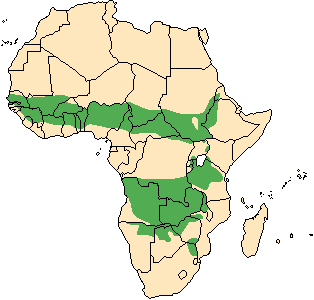![]() Return
to Artiodactyla
Return
to Artiodactyla
Classification
|
 Hippotragus
equinus
Hippotragus
equinus
Roan antelope
![]()
Taxonomy
 |
 |
 |
Click on the images above for a larger view of the
photographs
|
||
General Characteristics
Body Length: 220-265 cm / 7.3-8.8 ft.
Shoulder Height: 140-160 cm / 4.6-5.3 ft.
Tail Length: 60-70 cm / 2-2.3 ft.
Weight: 225-300 kg / 495-660 lb.The upper body is grizzled grey to roan in colour with the legs darker. The underparts are white. On the face there is a black/brown and white facial mask, slightly lighter in females, that consists of a white spot on either side of the eye and a white muzzle. On the neck and withers is an erect, dark-tipped mane, while a light 'beard' is present on the throat. A long tuft of dark hair is present on the tips of the ears. The arched, ringed horns are found in both sexes, though slightly smaller in females, grow 60-100 cm / 2-3.3 feet long.
Ontogeny and Reproduction
Gestation Period: 268-280 days.
Young per Birth: 1
Weaning: 4-6 months.
Sexual Maturity: At 2.5-3 years.
Life span: Up to 17 years.There does not appear to be a specific breeding season for this species. Females become sexually receptive within three weeks of giving birth, and are capable of reproducing every 10-10.5 months. A pregnant female will separate from her herd prior to giving birth, and remain with her new calf for about five days afterwards. After the female has rejoined the herd, the young calf remains concealed for five more weeks, subsequently joining a 'creche' with other youngsters in the herd.
Ecology and Behavior
Roan antelope are usually most active in the morning, late afternoon, and evening. Roan antelope are relatively unwary, running away from a potential source of danger for a short distance, then stopping to look back. However, when pressured, they can run up to 57 kilometers per hour for considerable distances. If cornered, these antelope are formidable opponents, charging and brandishing their horns with skill. Roan antelope never move far from water (~4 kilometers at most), and overall have localized movements, using 200-400 hectares at any given time, with a home range no more than 10,000 hectares throughout the year. Neighbouring herds rarely share territory. Female herds are accompanied by a single adult male, who defends a wide swath (300-500 meters) around his herd against potnential rivals. Young males are driven from their natal herds when they reach 2.5 years of age. Fighting for dominance is prevalent among both males and females, with the most dominant initiating herd movements. Fights occur with both animals on their "knees" (carpal joints) and are almost exclusively horn against horn.Family group: Harem groups with a single dominant male with 6-15, rarely up to 35, animals. Males associate in bachelor herds of 2-5 animals.
Diet: Medium high grasses, rarely leaves.
Main Predators: Lion, leopard, spotted hyena, Cape hunting dog.
Distribution
Lightly wooded country and grasslands throughout most of central Africa.

Range Map (Redrawn from IEA, 1998)
Conservation Status
The roan antelope is classified as a low risk, conservation dependent species by the IUCN (1996).
Remarks
The name "roan" is likely of the same origin as the species name equinus: the colour roan, a grizzled mahogany, is also seen in horses. Antelope is from anthalops (Greek) a horned animal, probably an antelope. Another possibility, and also possibly the stem of anthalops, is anthos (Greek) a flower and ops (Greek) the eye which seems to refer to the large, beautiful eyes of these ungulates. Hippos (Greek) a horse; tragos (Greek) a he-goat. Equus (Latin) a horse, thus equinus - relating to horses.
Literature Cited
IEA (Institute of Applied Ecology). 1998. Hippotragus equinus. In African Mammals Databank - A Databank for the Conservation and Management of the African Mammals Vol 1 and 2. Bruxelles: European Commission Directorate. Available online at http://gorilla.bio.uniroma1.it/amd/amd172b.htmlKingdon, J. 1997. The Kingdon Field Guide to African Mammals. Academic Press, London and New York: NaturalWorld.
Nowak, R. M. [editor]. 1991. Walker's Mammals of the World (Fifth Edition). Baltimore: The Johns Hopkins University Press.
Walther, F. R. 1990. Roan and Sable Antelopes. In Grzimek's Encyclopedia of Mammals. Edited by S. P. Parker. New York: McGraw-Hill. Volume 5, pp. 437-447.
Wilson, D. E., and D. M. Reeder [editors]. 1993. Mammal Species of the World (Second Edition). Washington: Smithsonian Institution Press. Available online at http://nmnhwww.si.edu/msw/
Return to Artiodactyla

![]()
© Brent Huffman, www.ultimateungulate.com |
|
|